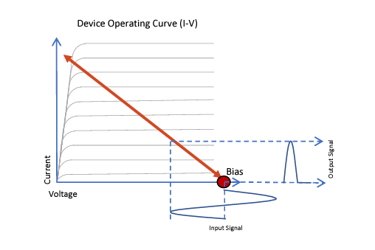Amplifier Classification: A vs. AB

Amplifiers are designed in many ways. One distinction is how the amplification devices are biased. They can be biased in different ways that affect performance and efficiency. This is called the Class of operation. Class A, B, or AB are commonly used and referred to in specifications for high power RF & Microwave amplifiers.
We discuss in this paper the differences between the different classifications and what it means with respect to performance. There are more classes of operation Class C, D, E… these are less common, and custom designed for individual tasks where high efficiency and linearity are not a concern.
What is meant by bias? An amplification device such as LDMOS, MOSFETs, GaN, or GaAs are the heart of the amplifier. Having properties and frequency response, manufacturers choose or develop based on these for the frequency band, power & application. Each device, however, needs to be biased; it is set at a voltage and current at its steady state. The setting of this bias is what now determines its classification.
Get unlimited access to:
Enter your credentials below to log in. Not yet a member of RF Globalnet? Subscribe today.
